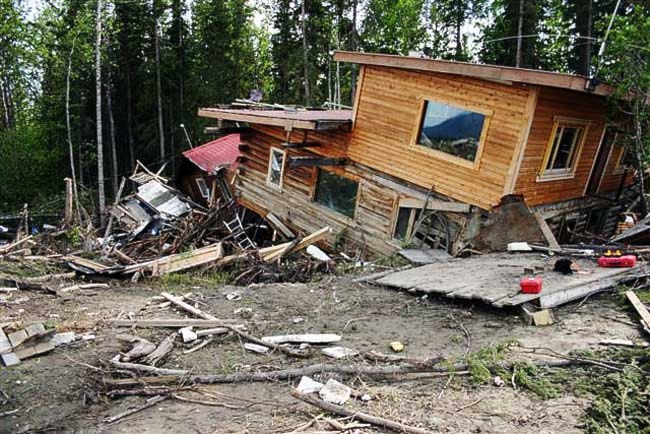The biggest springtime flood on record nearly destroyed Eagle, Alaska.
Dawson City residents are finishing the job.
There’s work to be done before the town can be rebuilt, after all.
What can be salvaged must be pulled from homes smashed beyond repair by river ice.
And, once gutted, those homes must be demolished and cleared away before the race begins to build new homes before the long winter arrives.
Enter a gang of nine Dawsonites who rolled into Eagle earlier this month in a van stuffed with supplies, during the first of several similar trips.
Over a weekend, they helped pull apart a house and salvage belongings. They built an outhouse for an elderly women. They pulled screws and nails.
Hardly glamorous work. But their help was immensely appreciated by Eagle residents who had lost their home and belongings. Blindsided by the flood, many didn’t know where to start.
“It’s huge. The response from Dawson has by far been the biggest response we’ve had. It’s been incredible,” said Andy Bassich, who is co-ordinating the rebuilding efforts in Eagle.
“On the ground, by far, the Canadians and the people from Dawson City have been by far the biggest on-the-ground contributor to helping us here.
“The compassion really comes through. They care about us. They’ve obviously been through this before.”
Dawson was hit by a flood in 1979 so severe that residents paddled down the city’s main streets in canoes and entered buildings through second-storey balconies. Bits of boardwalk became unmoored and drifted through town, in some cases carrying dogs as passengers.
But the damage wreaked by Eagle’s flood in early May was far more terrible.
Buildings nearest to shore suffered the worst damage as unclogged jumble ice steamrolled through town, knocking buildings off their foundation and flattening pick-up trucks, freighter canoes and fish wheels.
The village’s hotels, restaurant and general store were all wrecked by the onslaught. And the old village is completely wiped out, its buildings either flattened or shoved up into the forest.
It’s believed that 35 homes were destroyed or displaced. Fifteen businesses were destroyed or severely damaged.
Further from the river, another 24 homes were flooded. At the flood’s peak, waters reached 16.5 metres above normal, reported the Fairbanks Daily News Miner.
The flood ruptured diesel tanks, leaving the wrecked town reeking of fuel. The flood also fouled the town’s wells.
Remarkably, no one died during the flood, save a few dogs.
Water is now being trucked in from Tok. The general store has re-opened in a new building. Fuel is now available. But the village’s tourism infrastructure is destroyed. Belongings remain strewn around town. Many remain without homes.
US President Barack Obama declared a state of emergency in Eagle earlier this month. But, while federal and state authorities were quick to supply food and clean water to Eagle’s residents, help with reconstruction has proven far more sluggish.
Dawson’s Bill Bowie visited Eagle first and saw its residents needed help.
He approached Eldo Enns, Dawson’s chief administrative officer. Enns in turn called Jack Vogt, who has performed disaster relief in South America.
Soon they had their van full of supplies and volunteers.
“None of us were prepared for what we saw. We were all in a state of awe. Devastation,” said Enns. “I thought, wow, this town was just eaten up.”
What was closest to the water was completely destroyed. Further up, the destruction was like that in a town hit by a tornado, with one building completely destroyed next to another that appeared untouched, said Enns.
He recalls peering into one building, knocked so far a kilter that you could see through its second-storey balcony from the ground deck. Resting on the dining-room table were hands of playing cards, left undisturbed after its occupants had fled.
One car had been crushed by ice so that “the highest point was the stick-shift. That’s how flattened that car was,” said Enns.
Over the weekend the Dawsonites stripped from a home everything worth saving, then cut the building in half and hauled it away with a commandeered front-end loader.
Eagle hopes to rebuild 13 homes that belonged to full-time residents before winter.
The new homes will be modest: two-storey log cabins, 5.5 by six metres.
Each cabin is expected to cost $40,000. Federal disaster money only covers up to $30,000. But the Samaritan’s Purse, an international Christian relief agency, recently agreed to pay the remaining cost for each home.
They hope to begin construction in early July. But there’s a lot of salvage work to be done before then.
“We’re really working on trying to ramp up our volunteer efforts, so we can get our salvage done on the homes before they get destroyed,” said Bassich.
Vogt has led several follow-up salvage trips this month. And Dawsonites have helped in other ways, too.
Bowie’s business, Arctic Inland Lumber, has donated slab wood, sheds and firewood. The Pioneer Women of the Yukon raised enough money to buy a nailer. Hotels have donated linen and pillows.
And the Yukon Queen II is now providing free transportation for volunteers from Dawson to Eagle.
But more help is still needed.
To assist in Dawson’s relief efforts, call Jim Regibald at 993-7407.
Contact John Thompson
at johnt@yukon-news.com.
